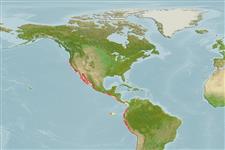Elasmobranchii (sharks and rays) >
Carcharhiniformes (Ground sharks) >
Triakidae (Houndsharks) > Triakinae
Etymology: Mustelus: Latin, mustela, -ae = weasel (Ref. 45335).
Environment / Climate / Range
Ecology
Marine; demersal; depth range 0 - 281 m (Ref. 96339). Subtropical, preferred 27°C (Ref. 107945); 43°N - 18°S, 126°W - 72°W (Ref. 55310)
Eastern Pacific: northern California, USA to the Gulf of California; Ecuador and Peru.
Length at first maturity / Size / Weight / Age
Maturity: Lm ?, range 51 - 63 cm
Max length : 100.0 cm TL male/unsexed; (Ref. 31395); max. reported age: 13 years (Ref. 6098)
Adults are found on the continental shelves from the intertidal region to at least 200 m depth. They feed on crabs, ghost shrimps, mantis shrimps, isopods, squids, polychaete worms, tunicates and small bony fishes. Viviparous (with a yolk-sac placenta), with 3 to 5 young in a litter. Size at birth between 19 and 21 cm. Readily kept in captivity. Utilized for human consumption. Marketed fresh, smoked and frozen (Ref. 9987).
Viviparous with a yolk-sac placenta; with 3 to 5 young in a litter. Size at birth ranges from 19-21 cm (Ref. 244). Distinct pairing with embrace (Ref. 205). Polyandry is a common life history strategy among the elasmobranchs and for M. henlei, the occurrence and frequency of polyandric behavior may vary depending on location and density of breeding individuals (Ref. 95902).
Compagno, L.J.V., 1984. FAO Species Catalogue. Vol. 4. Sharks of the world. An annotated and illustrated catalogue of shark species known to date. Part 2 - Carcharhiniformes. FAO Fish. Synop. 125(4/2):251-655. Rome: FAO. (Ref. 244)
IUCN Red List Status (Ref. 115185)
CITES (Ref. 94142)
Not Evaluated
Threat to humans
Harmless
Human uses
Fisheries: highly commercial; gamefish: yes
More information
ReferencesAquacultureAquaculture profileStrainsGeneticsAllele frequenciesHeritabilityDiseasesProcessingMass conversion
Tools
Special reports
Download XML
Internet sources
Estimates of some properties based on models
Phylogenetic diversity index (Ref.
82805): PD
50 = 0.5000 [Uniqueness, from 0.5 = low to 2.0 = high].
Bayesian length-weight: a=0.00224 (0.00111 - 0.00453), b=3.18 (3.01 - 3.35), in cm Total Length, based on LWR estimates for this Genus-body shape (Ref.
93245).
Trophic Level (Ref.
69278): 3.6 ±0.4 se; Based on diet studies.
Resilience (Ref.
69278): Low, minimum population doubling time 4.5 - 14 years (rm=0.127; K=0.26; tm=2-6; tmax=15; Fec=3).
Prior r = 0.17, 2 SD range = 0.02 - 1.11, log(r) = -1.77, SD log(r) = 0.95, Based on: 1 M, 1 K, 4 tgen, 1 tmax, 2 Fec records
Vulnerability (Ref.
59153): High vulnerability (58 of 100) .
